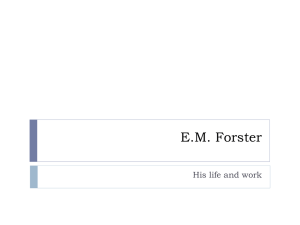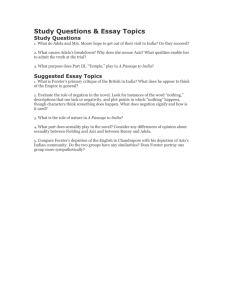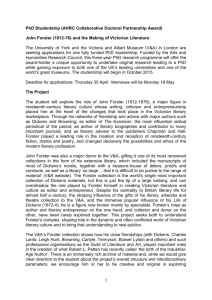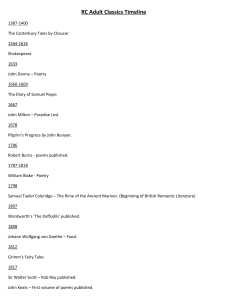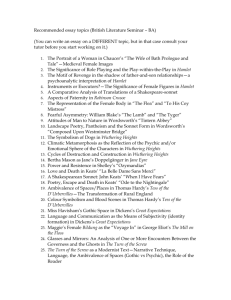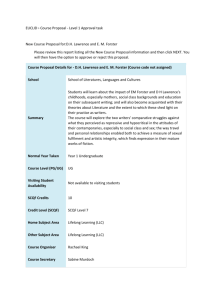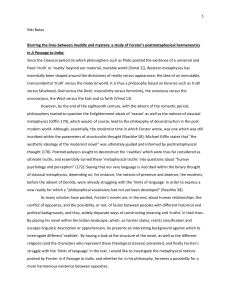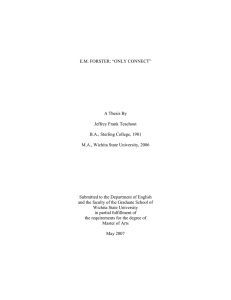E. M. Forster
advertisement
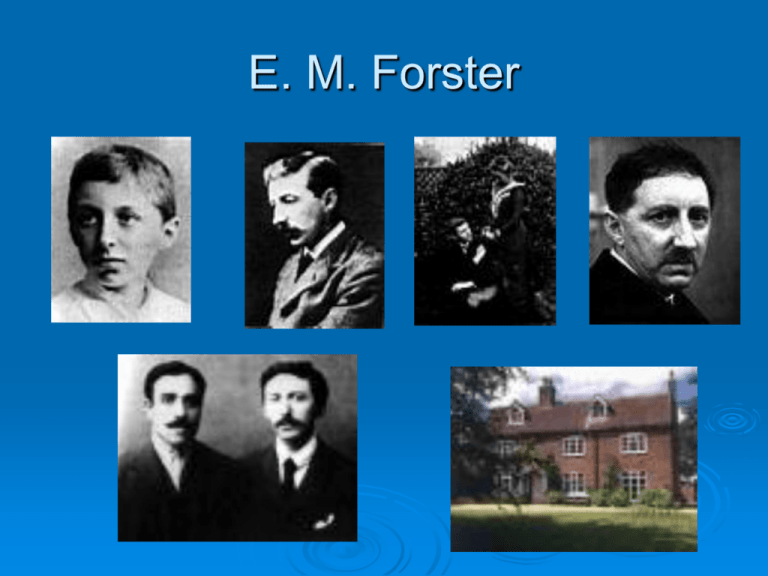
E. M. Forster E. M. Forster’s life Birth: 1879 born in London, son of an architect Aunt: Marianne Thornton, leaving Forster ₤8.000, enough for him to live on and enabled him to become a writer. King’s College, Cambridge: 1897-1901 Bloomsbury Group: 1910s-1920s. In the atmosphere of skepticism, he became under the influence of Sir Jamer Frazer, Nathaniel Wedd, Goldsworthy Lowes Dickinson, and G.E. Moore, and shed his not very deep Christian faith. E. M. Forster’s Life Travel: Italy and Greece with his mother; Egypt, Germany and India with the Classicist Goldworthy Lowes Dickinson in 1914 Lovers: 1. Mohammed el-Adl, 1916-17 in Alexandria, Egypt; “Good-night, my lad, for nought’s eternal; No league of ours, for sure” 2. Kanaya, 1920s in India, first ongoing sexual relationship of his life E. M. Forster’s Life After the age of 45: stopping writing novels, producing little more fiction apart from short stories only for himself and a small circle of friends Successful BBC broadcaster in the 1930s and 1940s Honorary fellowship at King’s College, Cambridge Death: died in Coventry at the age of 91 in 1970. E. M. Forster List of Works by E. M. Forster Film Adaptations Key themes in Forster’s novels 1. The pursuit of personal connections in spite of the restrictions of contemporary society 2. The irreconcilability of class differences 3. Sexuality: a general shift from heterosexual love to homosexual love over the course of his writing career. (the posthumously published novel Maurice and the short-story collection The Life to Come Forster’s Novel: Howards End Plot summary: SparkNotes Directed by James Ivory, 1992 Emma Thompson, the best actress Howards End Maurice (directed by James Ivory, 1987) A homosexual love story Plot Summary: Wikipedia A Passage to India (1984 directed by David Lean) Plot Summary: novel film A Passage to India Published in 1924, the last completed novel that Forster published during his lifetime. Major Characters in the novel: 1. Dr. Aziz: 2. Cyril Fielding 3. Adela Quested 4. Mrs. Moore 5. Professor Narayan Godbole 6. Ronny Heaslop A Passage to India (1984 directed by David Lean) Themes: 1. the difficulty of friendship between an Englishman (the colonist) and an Indian (the colonized) 2. the racism and oppression of the British who rule India 3. the “muddle” of Indian civilization and psychology, and the oneness (and perhaps sameness) of all life A Room with a View in 1908, Forster’s most famous and popular novel. Time background: the British Empire’s zenith, the Brits enjoyed the fruits of a system of exploitation and oppression Spatial background: Part I and the last chapter: Florence, Italy Part II: Surrey, England Published A Room with a View Cultural and Social background: 1. The remnants of Victorian sensibilities: A. refinement B. the virtue of young girls C. the control of passions 2. A time of change: A. Women began to clamor more loudly than ever for equal rights B. Socialists were challenging old ideas about class and religion C. Artists and thinkers began to challenge Victorian attitudes about emotion and sexuality A Room with a View Major Themes: 1. Propriety and Passion 2. The beauty of human beings 3. Travel and the idea of Italy 4. The beautiful and the delicate 5. Woman’s position and independence 6. Connection between nature and man A Room with a View Major themes: 7. Passion and the body 8. The Medieval/the Renaissance/the Classical 9. Music 10. The muddle 11. Class snobbery A Room with a View Symbolic meanings of “rooms” and “views”: “rooms”: conservative and uncreative, e.g. Mrs Honeychurch, Cecil usually pictured in a room “views”: forward-thinking and modern character types, e.g. Freddy and the Emersons often described as being “outside” A Room with a View The symbolic differences between Italy and England: Forster idealized Italy as a place of freedom and sexual expression. Italy promised raw, natural passion that inspired many Britons at the time who wished to escape the constrictions of English society. While Lucy is in Italy her views of the world change dramatically, and scenes such as the murder in the piazza open her eyes to a world beyond her “protected life in Windy Corner”. The Essay Topic To understand E. M. Forster’s novel A Room with a View, it is critical to have a sound background knowledge about the Victorian era, especially the Victorian attitudes about emotion and sexuality, women’s position in this time. Write an essay about 3-5 pages to explore the aforementioned background knowledge.

